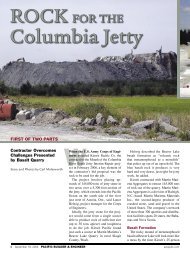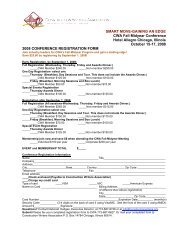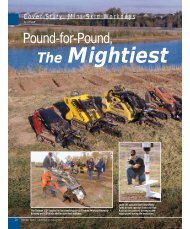A Concise History - Construction Writers Associations
A Concise History - Construction Writers Associations
A Concise History - Construction Writers Associations
You also want an ePaper? Increase the reach of your titles
YUMPU automatically turns print PDFs into web optimized ePapers that Google loves.
C onstruction <strong>Writers</strong> Association<br />
not much else, until the meeting in Atlantic<br />
City. “There was a considerable group of<br />
writers in attendance,” Halmos said, including<br />
Bill Quirk, Jim Jenkins, Ed Weilepp, then<br />
editor for Kansas <strong>Construction</strong>, Art Faber of<br />
the Associated Equipment Distributors, John<br />
Rehfield (then with a predecessor of <strong>Construction</strong><br />
Equipment), Duane Cronk (then a<br />
freelance writer in Washington), Halmos,<br />
and others.<br />
“At that meeting, we decided the idea of<br />
forming CWA was good and we should go<br />
ahead, using as our basis the statement in<br />
the later-adopted Constitution and By Laws<br />
that stated the purpose of the association,”<br />
Halmos said. The purpose later was<br />
engraved on metal plaques that were distributed<br />
to members.<br />
Weilepp was elected the first president of<br />
CWA, following its organizational meeting<br />
in Chicago Jan. 27, 1957. Other officers<br />
included vice president Jenkins, American<br />
Road Builder Magazine of the American<br />
Road Builders Association, Washington,<br />
D.C., now the American Road & Transportation<br />
Builders Association, and secretarytreasurer<br />
George E. Symons, Modern Highways<br />
Magazine, New York City. Other<br />
founders included Quirk, editor, Contractors<br />
& Engineers Monthly Magazine, and Halmos,<br />
senior editor, Engineering News-Record<br />
Magazine, both of New York.<br />
“The organization, a professional society,”<br />
said an early CWA release, “has as its<br />
main objective the improvement of standards<br />
of construction writing throughout the<br />
industry, and adequate recognition of these<br />
writers.”<br />
“It [the organizational meeting] was in a<br />
sample room at the Conrad Hilton Hotel in<br />
Chicago in January of 1957, provided to us<br />
through the courtesy of [AED editor and future<br />
CWA president] Art Faber,” wrote<br />
Weilepp in 1998. “There were about 20 of us<br />
there, covering the AED annual convention.<br />
“As the editor of a small, one-state construction<br />
publication, I was the ‘compromise’<br />
candidate to get the thing started. At least<br />
two big national books were after the ‘honor,’<br />
and to forestall a battle which could have<br />
killed the organization for a couple of years,<br />
I was elected. I was re-elected a year later as<br />
we struggled to get going. I also did the work<br />
of secretary — or my girls in the office did —<br />
and we had no treasurer because I don’t<br />
believe we collected any money those first<br />
two years.”<br />
In 1998, long-time member M.D. “Doc”<br />
Morris, P.E., then a senior editor with Mc-<br />
Graw-Hill’s <strong>Construction</strong> Series, and 1997<br />
Silver Hard Hat winner, said seeing founding<br />
member Halmos at CWA meetings<br />
“harkened me back to the early Fifties in<br />
New York City, when I was a green kid<br />
among the likes of him, Bob Dodds, Ed<br />
Cleary, Hank Perez, and Bill Quirk.”<br />
Morris said that Quirk’s kindness and technical<br />
acumen was spread widely, which is the<br />
kind of networking that CWA is all about.<br />
“Bill and I stayed close friends for the rest<br />
of his life,” Morris recalled. “Over those<br />
years I began teaching technical writing,<br />
expanding some of [Quirk’s] first lessons to<br />
me. By helping me, Bill Quirk indirectly<br />
helped 15,000 subsequent students to write<br />
better, and countless readers to get lively,<br />
profitable information, all from the kind<br />
concern of a true professional.”<br />
CWA in the Sixties<br />
In 1964, wall-hung metal plaques were distributed<br />
to members, with the CWA logo at<br />
top, a banner in which the member’s name<br />
was to be engraved and the purpose of the<br />
association, to which CWA members subscribed:<br />
To establish and maintain the highest<br />
standards of quality and veracity in the<br />
gathering, writing and dissemination of<br />
information concerning the <strong>Construction</strong><br />
Industry; [and] To advance the<br />
cause of the <strong>Construction</strong> Industry in<br />
the interest of its own progress and in<br />
promotion of the national welfare.<br />
CWA’s first newsletter appeared in July<br />
1963. “As you know,” the first newsletter<br />
assumes optimistically, “our last annual<br />
meeting decided that we should issue some<br />
sort of newsletter to our members – to keep<br />
them abreast of what the organization<br />
and its officers and committees<br />
have been doing – and eventually<br />
to provide a forum for exchange<br />
of ideas, suggestions and news of<br />
members. This, then, is our first<br />
Ed Weilepp,<br />
first president<br />
of CWA.<br />
3








